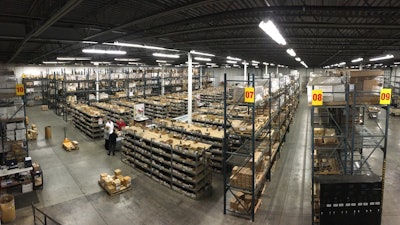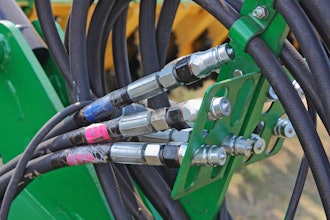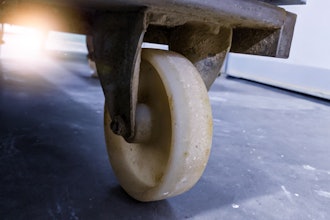
How can you optimize the performance of your warehouse? It’s complicated. Where there’s complexity, variability, and significant financial investment, there’s often room for improvement. So where do you start? By breaking this work into manageable pieces: spaces, places, and people.
What’s Taking up all That Space?
For a financial analyst, there may be five or six metrics to rely on when reviewing a company. One of them is usually inventory turns, an indicator of how well a company is being managed. Specifically, it is a ratio that indicates how many times a company sells and replaces its stock of goods during a particular period. The formula takes the cost of goods sold over a given period of time and divides it by the average inventory value for that same period. Generally speaking, the higher the inventory turns, the better, when compared to other, similar businesses in the same industry. A lower number, on the other hand, can indicate weak sales or too much inventory. Calculating this number is the starting point for understanding what’s taking up space.
During a recent supply chain assessment for a parts manufacturer in the oil and gas industry, on average, four or five months of inventory were identified. Some items represented a few days’ worth of inventory, while for others, there were years of demand. When low-volume inventory is occupying space needed need for fast movers, it’s too expensive. Knowing the average demand of each product is another critical indicator for understanding how efficient your warehouse really is.
How recently has your organization updated its processes around expiration and obsolescence? Understanding and monitoring inventory product life can greatly impact your space. Expiration is relevant for all perishable items: things can go bad. Metal can rust. Food certainly goes bad. Obsolescence is also important, but it is sometimes less clearly defined. For example, a health and beauty consumer product company uses one red for their Valentine's Day packaging and another for Christmas. By Christmas, the Valentine's Day red is obsolete. The February red could never be used again and yet an entire row in their warehouse was stuffed full of it.
In some cases, if your product isn’t expired or could be used by someone else, some inventory may be able to be returned to the supplier for a restocking fee. If you have an excess amount worth $50,000 and the supplier charges you $10,000 to take it back, you have $40,000 and valuable space available for product that turns. If restocking isn’t a part of your current supplier agreements, perhaps it is an opportunity to investigate.
Getting a handle on what is moving, what isn’t, and what has been around longer than anyone can remember can seem daunting at first. But establishing a clear picture, both on paper and on the floor, can improve efficiency and generate savings.
Everything in its Place
Warehouse managers love a full, busy warehouse. 5S is a lean best practice for workplace organization, and applying 5S benefits warehouse personnel directly. The system focuses on putting everything where it belongs and keeping the workplace clean, making it easier for people to do their jobs without wasting time or risking injury.
- Sort – remove all non-active items to free up space
- Set in order – determine optimal storage locations based on frequency of activities like picking and restocking
- Shine – replace worn and broken things, label clearly, assess lighting
- Standardize – common equipment, rack sizing, and labels to increase efficiency and reduce errors
- Sustain – audit to return any discrepancies to standard, such as end of shift, daily, or weekly
Sorting is a deceptively simple part of 5S: getting rid of stuff that doesn't belong. Though this may sound obvious, companies often don’t set aside the time to do it thoroughly, and there’s always a dark corner to hide an unwanted project in. It’s not unusual to find old printers, CRT monitors, office supplies, photocopy paper, and forgotten personal belongings cluttering valuable space.
At a recent client, one of the first things noted, before measuring and recording pallet dimensions, was the incredible amount of open air - the most expensive air in warehousing. Start trading in square feet to go up in cubic feet. Instead of having one level on the floor, there might be four or five going up. It takes time to use a forklift to pick things up and bring them down, but comparably, it can be a worthwhile trade.
Rack utilization is also important. When loading two 4-foot pallets onto a 10-foot rack, a negative 2-foot space is created. Now consider – can the pallets be rotated to add a third? If the pallet size can’t be re-worked to advantage, is there space to be gained in eliminating unnecessary packaging? In that case, the cost to make the change may rest with the supplier, generating immediate savings.
Another target for review: how effective is the layout for picking efficiency? Examining traffic patterns in the space can reveal epic journeys that lead to tired employees with few items to show for their efforts. Logically, warehouses are often organized with high volume product at the front of the aisles. Easy targets for efficiency surface when you consider whole ordering patterns rather than single item volumes. Perhaps consumers buying toilet paper often buy paper towels at the same time. Opportunities for grouping items in the same aisle makes picking easier, achieving more value for the miles walked.
People are People
The behavior of the buyer, whether a lone individual or an entire team in the purchasing department at a large organization, plays a key role in the warehouse ecosystem. For some businesses, the person that handles buying doesn't like to order very often, either to make their own job easier, or to get a small volume discount. If they've got the space, they may buy a whole truckload under the premise that they can just store it. Assessing how often to buy and how much to buy each time can be worth millions of dollars.
Once items enter a warehouse, people are often reluctant to throw anything away: they paid real money for these items. Departments fueled by different goals can work against each other. What if the sales department comes back in six months to say, “Hey, great news! We have a sale and can finally move that product.” Supply chain doesn’t want to respond with, “We threw it away.” A well-organized plan with clear rules on how often to review current, expired, and obsolete inventory goes a long way toward clarity for all involved.
Keep it Simple
Owners and managers around the world dream of a warehouse that clicks along like a finely tuned machine, humming with activity. Such a machine is precise,  Johnson
Johnson
Keith Johnson is a principal with Firefly Consulting. He has helped companies in the US and Europe identify and execute projects that save $10M to $200M per year while focusing on customer needs and increasing productivity.























